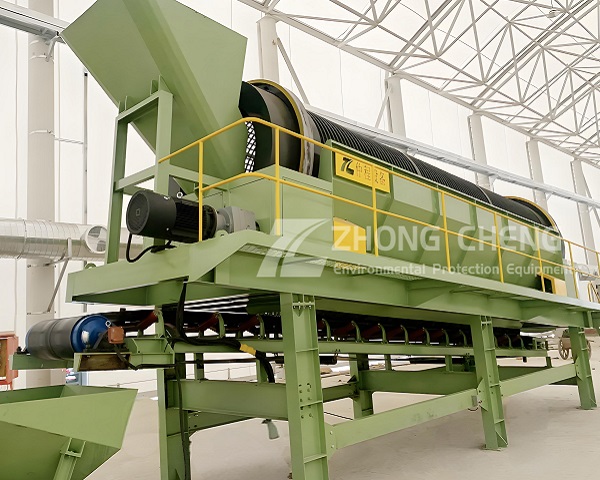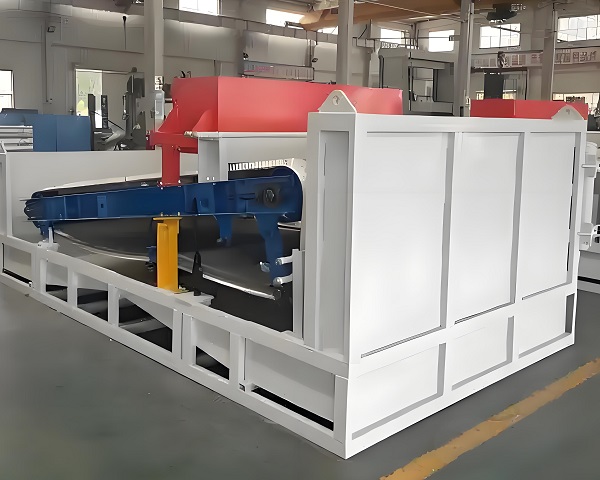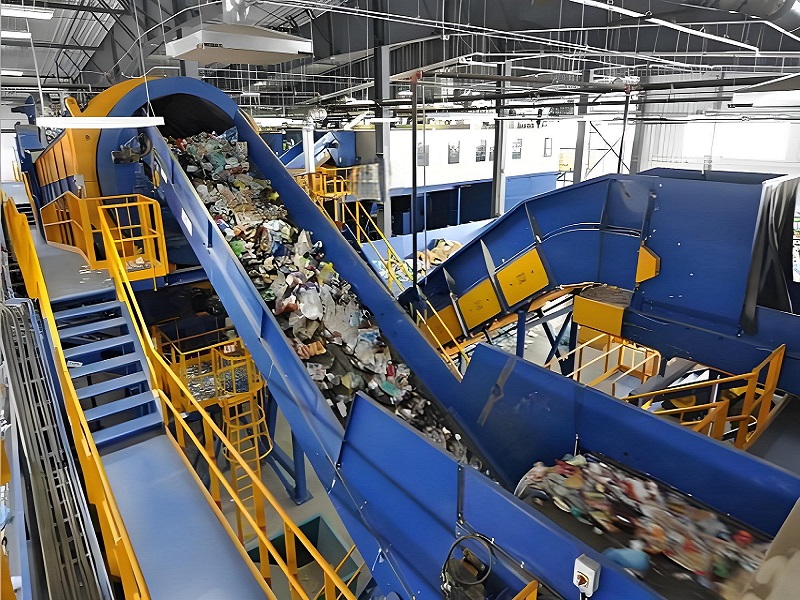The aged waste screening and processing system is a comprehensive equipment system for the resource recovery of waste accumulated in landfills over many years. With the continuous upgrading of urban waste disposal methods, large amounts of municipal solid waste initially disposed of through landfills have gradually become a key target for environmental governance. This waste, which has been landfilled for many years and has naturally decomposed, is called "aged waste." Its internal materials have undergone long-term fermentation and decomposition, exhibiting a loose structure and complex composition, mainly including humus, plastics, metals, glass, bricks, and residual organic matter.
Aged waste contains a large amount of reusable resources, such as metals like iron, copper, and aluminum, as well as recyclable materials such as plastics and combustibles. Through scientific mechanical screening and sorting processes, resource recycling can be effectively achieved, reducing secondary landfill volume and lowering environmental pollution. The aged waste screening system is the core equipment for accomplishing this task. It achieves waste grading, purification, and reuse through a combination of physical sorting and mechanical screening equipment.
Main Equipment and Functions
The entire aged waste screening system consists of several key pieces of equipment, typically including a feeder, bag breaker, drum screen, air separator, magnetic separator, eddy current separator, conveying system, dust removal system, compression baler, and control system. The following is a detailed description:
1. Feeding Machine

Function: The feeder is the starting point of the entire system, responsible for evenly and stably feeding the aged waste into the subsequent equipment. Because aged waste contains complex components such as soil, stones, and plastic bags, directly loading it into the screening equipment can easily cause blockages and uneven feeding. Through the vibrating or chain conveyor structure of the feeder, stable feeding can be achieved, ensuring continuous operation of the system.
Features and Parameters:
Common Types: Vibrating feeder, chain feeder, belt feeder;
Power Range: 5–15kW;
Conveying Capacity: 20–100 tons/hour;
Features: Variable frequency speed regulation, anti-jamming design, automatic feeding speed control.
The uniformity of the feeder directly affects the accuracy of subsequent sorting and is the first step in ensuring the stable and efficient operation of the system.
2. Bag Opener
Function: Some garbage bags in aged waste may not be completely broken. If they are not broken in advance, it will affect the screening effect. The main function of the bag opener is to cut open the closed garbage bags through a rotating cutter roller or chain tearing device, loosening the internal material and facilitating subsequent screening and sorting.
Features and Parameters:
Power: 15–30kW;
Processing Capacity: 20–80 tons/hour;
Structure: Low-speed, high-torque design, anti-tangling, anti-jamming;
Features: Wear-resistant and replaceable blades, suitable for various types of waste.
The bag opener is the system's "pre-treatment equipment," creating favorable conditions for subsequent screening and preventing garbage bags from passing through the screen in whole pieces.
3. Trommel/Vibrating Screen

Function: Screening equipment used to separate materials according to particle size. The fine particles (10–80 mm in diameter) typically separated by screening are humus and organic matter, which can be directly used for land reclamation or composting; while larger particles contain recyclable components such as plastics, metals, glass, and stones.
Features and Parameters:
Power: 15–45 kW;
Processing Capacity: 20–80 tons/hour;
Screen Size: Adjustable 10–80 mm;
Features: Drum screens are suitable for materials with high mud content and are less prone to clogging; vibrating screens offer high screening accuracy and are easy to maintain.
Screening is one of the most crucial processes in the entire system, directly affecting the efficiency of subsequent sorting.
4. Air Separator
Function: The air separator utilizes aerodynamic principles to separate lightweight materials (plastic bags, paper scraps, films, etc.) from heavy materials (bricks, glass, soil, etc.) by adjusting wind speed and airflow angle, achieving preliminary purification.
Features and Parameters:
Power: 18–55kW;
Sorting Capacity: 15–60 tons/hour;
Features: Adjustable airflow, high sorting accuracy, low dust;
Applications: Often operated in conjunction with dust removal systems.
Air separators not only reduce the load on subsequent sorting processes but also significantly improve the separation effect of plastics and paper.
5. Magnetic Separator

Function: Magnetic separators use magnetic force to attract ferromagnetic metals (such as iron nails, iron sheets, steel wires, etc.), effectively removing metal impurities. This achieves metal recovery and prevents wear on subsequent equipment (such as eddy current separators).
Features and Parameters:
Power: 3–15kW;
Processing Capacity: 20–120 tons/hour;
Type: Permanent magnet drum, suspended electromagnetic magnet;
Features: Automatic unloading design, continuous operation, easy maintenance.
Magnetic separators are usually installed at the end of air separators or conveyor belts and are key equipment for metal recovery.
6. Eddy Current Separator
Function: Used to separate non-ferrous metals, such as aluminum, copper, and stainless steel fragments. Its working principle utilizes a rotating magnetic field to induce a current in a conductor, thereby generating a repulsive force that separates the non-ferrous metals from the waste.
Features and Parameters:
Power: 15–37kW;
Sorting Capacity: 10–50 tons/hour;
Features: High sorting accuracy, stable operation, and low maintenance cost.
This equipment enables efficient recovery of metal resources, increasing economic benefits.
7. Belt Conveyor System

Function: Responsible for connecting various processing units, enabling continuous material flow between equipment. The conveyor system is the "artery" of the entire screening line, and its efficiency directly affects the overall production capacity.
Features and Parameters:
Power: 2–11kW/unit;
Conveying Capacity: 10–300 tons/hour;
Features: Customizable length, adjustable speed, and simple structure.
To prevent dust generation, conveying systems are often designed as enclosed systems or equipped with dust covers.
8. Dust Collection System
Function: Large amounts of dust and odors are generated during screening and air separation processes. The dust collection system uses negative pressure ventilation and filtration devices to collect and purify the dust, ensuring a safe and compliant working environment.
Features and Parameters:
Power: 7.5–30kW;
Airflow: 5000–50000m³/h;
Type: Baghouse dust collector, cartridge dust collector;
Features: Automatic cleaning, dust removal efficiency up to 99% or higher.
The dust collection system is often used in conjunction with odor control devices to further reduce environmental impact.
9. Baler/Compactor
Function: Used to compress sorted recyclable materials (such as plastics, paper, and metals) into blocks for easy storage, transportation, and reuse. Baling not only reduces volume but also improves material stacking and transportation efficiency. Features and Parameters:
Power: 18–55kW;
Packaging Capacity: 5–20 bales/hour;
Features: Hydraulic drive, high compression ratio, automatic binding, safe and reliable.
Through baling, high-density recyclable materials can be formed, creating conditions for recycling.
10. Control System (PLC Central Control System)
Function: The automated control center for the entire production line, realizing equipment linkage control, operation monitoring, data acquisition, and alarm prompts. Through the PLC system, the operating status of each piece of equipment can be monitored in real time, parameters can be automatically adjusted, and system stability can be improved.
Features: Remote monitoring function; Visualized operation interface; Supports energy consumption and efficiency statistics.
The control system is a key link in achieving intelligent and unmanned operation, making the treatment of aged waste more efficient and reliable.
Equipment Collaboration and Process Flow

The system's operation flow is generally as follows:
Feeding → Bag breaking → Screening → Air separation → Magnetic separation → Eddy current separation → Conveying → Dust removal → Baling.
In this process, the various devices work seamlessly together to form a highly efficient material sorting and resource recovery chain.
Fine materials (mainly humus and organic matter) can be used for land reclamation, brick making, or composting; lightweight materials (plastics, paper) are washed or granulated for reuse; metallic materials are recovered after magnetic separation and eddy current separation; inert materials (bricks, glass) can be used for roadbeds or building materials; and residual waste undergoes secondary treatment or final landfill.
The aged waste screening and treatment system achieves precise waste sorting and maximizes resource utilization through mechanized and intelligent collaborative operations. It not only significantly reduces landfill volume and releases land resources but also effectively prevents secondary pollution, promoting urban solid waste management towards "reduction, harmlessness, and resource recovery."
This system features high efficiency, low energy consumption, automation, and sustainability. It is the core equipment for current aged waste management projects and a crucial technological support for building "zero-waste cities" and realizing a circular economy.